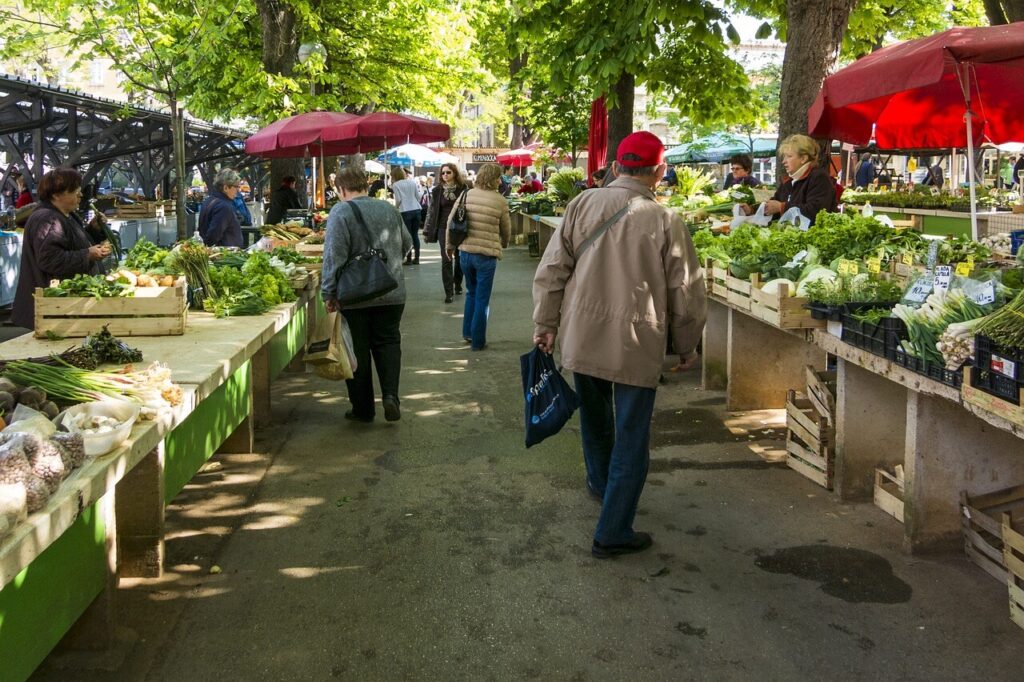
Introduction
Agritourism is a type of tourism that involves visiting working farms, ranches, or agricultural production facilities for the purpose of enjoyment, education, or active involvement in the activities of the farm. It is a growing industry that appeals to people who want to connect with nature, learn about sustainable agriculture, and experience rural life.
Definition of Agritourism:
Agritourism is a subset of rural tourism that involves a range of activities, including farm visits, farm stays, farmers’ markets, pick-your-own produce, and farm-to-table dining experiences. The purpose of agritourism is to provide visitors with an authentic and educational experience of agricultural production and rural life.
The appeal of connecting with nature through Agritourism:
In the age of modern technology and urbanization, many people are looking for ways to disconnect from their busy lives and reconnect with nature. Agritourism offers a unique opportunity to do just that by providing visitors with an immersive experience of the natural world. Whether it’s picking fresh produce straight from the farm, taking a tractor ride through the fields, or simply enjoying the peaceful surroundings of a working farm, agritourism allows visitors to engage with the natural world in a meaningful way.
Another appeal of agritourism is the opportunity to learn about sustainable agriculture and the importance of locally sourced food. Visitors can gain an understanding of how their food is produced and the impact that agriculture has on the environment. They can also learn about the challenges faced by farmers and the innovative techniques they use to overcome them.
The History and Evolution of Agritourism
Agritourism has its roots in the agrarian lifestyle that existed in many cultures throughout history. However, the modern concept of agritourism emerged in the late 20th century as a response to changes in the agricultural industry and a growing interest in sustainable and locally sourced food.
The Origins of agritourism
The origins of agritourism can be traced back to the 1970s, when farmers in Italy began opening up their homes and land to tourists, offering them an opportunity to experience rural life and taste local food. The idea quickly spread to other countries, such as France and Spain, and eventually made its way to the United States.
In the US, agritourism began to gain popularity in the 1980s and 1990s as a way for small farms to supplement their income and diversify their operations. Farmers started offering activities such as hayrides, pumpkin patches, and pick-your-own fruit and vegetable fields, and many also began selling their products directly to consumers through farmers’ markets and on-farm stores.
The growth and development of the industry
Today, agritourism has grown into a diverse industry that includes everything from farm stays and culinary tours to educational programs and farm-to-table dining experiences. The industry has also become an important economic driver in many rural areas, providing jobs and income for farmers and other local businesses.

Types of Agritourism
Agritourism encompasses a wide variety of activities and experiences that allow visitors to connect with agriculture, nature, and the rural lifestyle. Some of the most common types of agritourism include:
Farm stays and bed and breakfasts:
Visitors can stay overnight at working farms or ranches, either in private accommodations or shared living spaces. This type of agritourism allows guests to experience the daily workings of a farm or ranch, including chores, feeding animals, and harvesting crops.
Educational tours and workshops:
Many farms and ranches offer guided tours and hands-on workshops that teach visitors about agriculture, animal husbandry, and sustainable farming practices. These tours may include visits to crop fields, animal pens, and processing facilities, as well as demonstrations on cheese making, bread baking, or beekeeping.
Harvest festivals and farmers’ markets:
Many farms and ranches host seasonal festivals and events to celebrate the harvest, such as apple picking, pumpkin patches, or corn mazes. Visitors can also shop for fresh produce, baked goods, and artisanal products at local farmers’ markets, which often feature live music, food trucks, and children’s activities.
Pick-your-own fruit and vegetable farms:
These farms allow visitors to harvest their own fruits and vegetables directly from the fields, such as strawberries, blueberries, peaches, or tomatoes. This type of agritourism is popular among families with young children, who enjoy the hands-on experience of picking their own produce.
Wine and cheese tastings:
Many agritourism destinations offer wine tastings and tours of vineyards and wineries, as well as cheese tastings and tours of dairy farms and creameries. These experiences allow visitors to learn about the history and process of wine and cheese production, and to sample local varieties.
Overall, agritourism provides a unique opportunity for visitors to connect with nature, learn about agriculture and sustainable farming practices, and support local farmers and producers.

Examples of Agritourism Destinations
Agritourism destinations can be found all around the world, offering visitors the opportunity to experience different agricultural practices, cultures, and landscapes. Here are a few examples:
- Château de Pommard, Burgundy, France: This 18th-century castle is a wine estate that offers tours, tastings, and even a wine school for visitors. The estate practices organic and biodynamic agriculture and is located in the heart of the famous Burgundy wine region.
- Snoqualmie Falls Forest Theater and Trail, Washington, USA: This outdoor theater and trail is located on a historic farm that dates back to the early 1900s. Visitors can enjoy live theater performances, hike on the trails, and learn about the history of the farm.
- Lavender Fields, Provence, France: This picturesque farm is filled with lavender fields that bloom from June to August. Visitors can take tours of the fields, learn about the distillation process, and purchase lavender products.
- Skagit Valley, Washington, USA: This valley is known for its tulip fields that bloom every spring. Visitors can take self-guided tours of the fields, attend the annual Tulip Festival, and purchase fresh flowers.
- Yarra Valley, Victoria, Australia: This region is known for its wine and gourmet food. Visitors can take tours of the wineries, enjoy wine tastings, and dine at farm-to-table restaurants.
- Machu Picchu Pueblo, Peru: This town is located at the base of the famous Machu Picchu ruins. Visitors can stay in traditional Inca-style huts, enjoy local cuisine, and participate in cultural activities.
- Kona Coffee Living History Farm, Hawaii, USA: This historic farm was once a working coffee plantation. Visitors can take tours, learn about the history of coffee farming in Hawaii, and taste fresh Kona coffee.
- Villages of Provence, France: This region is known for its picturesque villages and traditional farming practices. Visitors can explore the villages, visit local markets, and participate in traditional cooking classes.
- La Fortuna, Costa Rica: This region is home to the famous Arenal Volcano and offers a variety of outdoor activities, such as hiking, white water rafting, and zip lining. Visitors can also enjoy hot springs and learn about sustainable farming practices.
- Tuscany, Italy: This region is known for its rolling hills, vineyards, and olive groves. Visitors can take tours of the wineries and olive oil mills, enjoy local cuisine, and stay in traditional Tuscan villas.
These are just a few examples of the many agritourism destinations available around the world. Whether you’re interested in wine, cheese, coffee, tea, or any other agricultural product, there is likely an agritourism destination that will offer you a unique and memorable experience.

Benefits of Agritourism
Agritourism provides a wide range of benefits, not just for visitors, but also for farmers and rural communities, as well as the environment. Some of these benefits include:
Economic benefits for farmers and rural communities:
Agritourism provides an additional source of income for farmers and other rural businesses. By diversifying their income streams, farmers can better withstand economic downturns and weather-related losses. This can also lead to increased economic activity in the surrounding areas, as visitors spend money on local goods and services.
Educational benefits for visitors:
Agritourism provides an opportunity for visitors to learn about agriculture and rural life. Visitors can experience hands-on activities such as harvesting crops, milking cows, or making cheese. This can help visitors gain a better understanding and appreciation of where their food comes from, and the hard work that goes into producing it.
Environmental benefits through sustainable practices:
Many agritourism operations use sustainable practices such as organic farming, conservation of water and other natural resources, and reduced use of pesticides and other chemicals. These practices can have a positive impact on the environment by promoting biodiversity, reducing pollution, and conserving natural resources.
Agritourism can help to promote sustainable rural development, preserve traditional agricultural practices, and provide a unique and educational experience for visitors.
Best Practices for Sustainable Agritourism
Sustainable agritourism involves practices that promote the preservation of natural and cultural resources, as well as supporting the local community. Here are some best practices for sustainable agritourism:
Conservation and stewardship of natural resources: Farmers should use sustainable practices to conserve soil, water, and other natural resources. This includes using organic farming methods, minimizing water use, and reducing chemical inputs.
Preservation of local culture and traditions: Agritourism should celebrate local culture and traditions, including food, music, and art. This can include showcasing traditional farming practices or featuring local artists and craftspeople.
Community involvement and support: Agritourism should involve and benefit the local community. This can include hiring local staff, sourcing local products, and supporting local businesses. Farmers can also work with community organizations to promote sustainable tourism and support local initiatives.
By following these best practices, farmers and agritourism operators can promote sustainable tourism that benefits both the environment and the local community.

Agritourism and Culinary Tourism
Agritourism and culinary tourism are two closely related industries that have been growing in popularity in recent years. Both industries focus on providing visitors with authentic and immersive experiences, whether it’s through exploring local farms and vineyards or enjoying regional cuisine.
The relationship between agritourism and culinary tourism:
Agritourism and culinary tourism often go hand in hand, as many agritourism experiences involve food and beverage tastings or farm-to-table meals. Culinary tourism can also involve visits to local markets, cooking classes, and food and wine festivals.
Farm-to-table restaurants and their role in agritourism:
Farm-to-table restaurants have become an important part of the agritourism industry, as they provide visitors with a direct connection to the local farmers and producers. These restaurants focus on using local, seasonal ingredients in their menus and often source directly from nearby farms and food artisans. By dining at these restaurants, visitors can taste the flavors of the region and support local businesses.
The rise of “agri-chefs” and farm-to-table cuisine:
As the demand for farm-to-table cuisine has grown, so too has the concept of “agri-chefs” – chefs who specialize in cooking with locally sourced ingredients. These chefs often have close relationships with the farmers and producers in their area and work closely with them to create menus that showcase the best of what the region has to offer.

The Future of Agritourism
Agritourism has continued to grow and evolve over the years, and there are many exciting trends and innovations in the industry that point toward a bright future. Some of the trends that are shaping the future of agritourism include:
- Agritech – The use of technology to improve farming practices and create more efficient and sustainable agricultural systems. This includes the use of precision farming tools, drone technology, and smart sensors to monitor crops and livestock.
- Farm-to-table experiences – More and more consumers are looking for locally sourced, organic, and sustainable food. This has led to a rise in farm-to-table experiences, where visitors can learn about where their food comes from and even participate in the growing and harvesting process.
- Agritourism as a form of education – As the world becomes more urbanized, there is a growing interest in learning about agriculture and rural life. Agritourism can help to bridge this gap by providing opportunities for visitors to learn about farming and agriculture.
- Sustainable development – With concerns about climate change and environmental sustainability on the rise, there is an increasing focus on sustainable development in the agritourism industry. This includes practices like regenerative agriculture, water conservation, and waste reduction.
The potential for growth and expansion in the agritourism industry is vast. As more people seek out unique travel experiences and a deeper connection to the environment, agritourism is poised to become an even more popular form of tourism. However, it’s important that this growth is sustainable and does not come at the expense of the environment or local communities. By promoting sustainable development, agritourism can continue to thrive while also benefiting farmers, rural communities, and visitors alike.
Conclusion
In conclusion, agritourism provides a unique opportunity for individuals to connect with nature and the source of their food. The industry has a rich history and has evolved to offer a wide range of experiences, from farm stays and educational tours to pick-your-own farms and wine tastings. Agritourism not only benefits farmers and rural communities economically but also provides educational and environmental benefits for visitors.
The industry’s future is promising, with trends and innovations focusing on sustainable development, which is essential for the preservation of natural resources and local culture. Overall, agritourism offers an opportunity for individuals to gain a deeper appreciation and understanding of the agriculture industry while enjoying the beauty of nature and delicious food.
Read more articles here.





